28 Common Backyard Birds in Kansas (with Pictures)
Last Updated on
t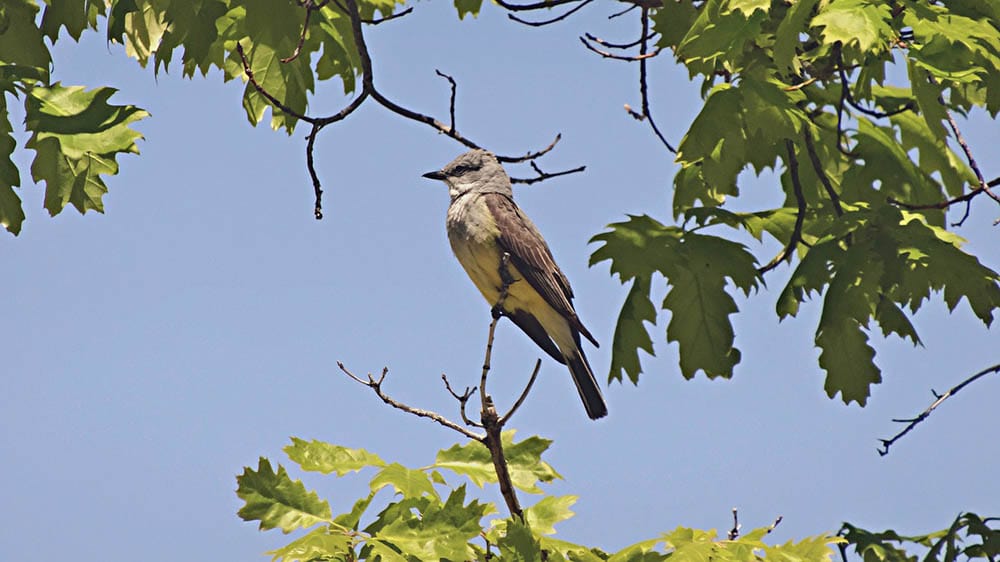
Kansas is known for its wide array of bird species. From small sparrows to ominous owls, this state has around 225 bird species that decorate urban and rural areas.
If you’re interested in observing your local birds, Kansas is the place to live. Several songbirds in Kansas can be observed right in your backyard. So, grab your birdwatching binoculars! We’re listing 30 common backyard birds that you can check off your list of birds to see.

The 28 Most Common Backyard Birds in Kansas
Year-Round Residents
1. Blue Jay

| Length | 11 inches |
| Wingspan | 16 inches |
| Habitat | Eastern Kansas, woodland areas |
| Diet | Omnivore |
| Colors | Blue, white, gray |
| Scientific Name | Cyanocitta cristata |
The Blue Jay is a beloved songbird by many Kansans for its striking blue feathers and “jay-jay-jay” call. The colors alone are enough for a double-take. You can find a Blue Jay in most counties across Kansas, especially eastern Kansas, where the plains turn into woodland landscapes.
2. Northern Cardinal
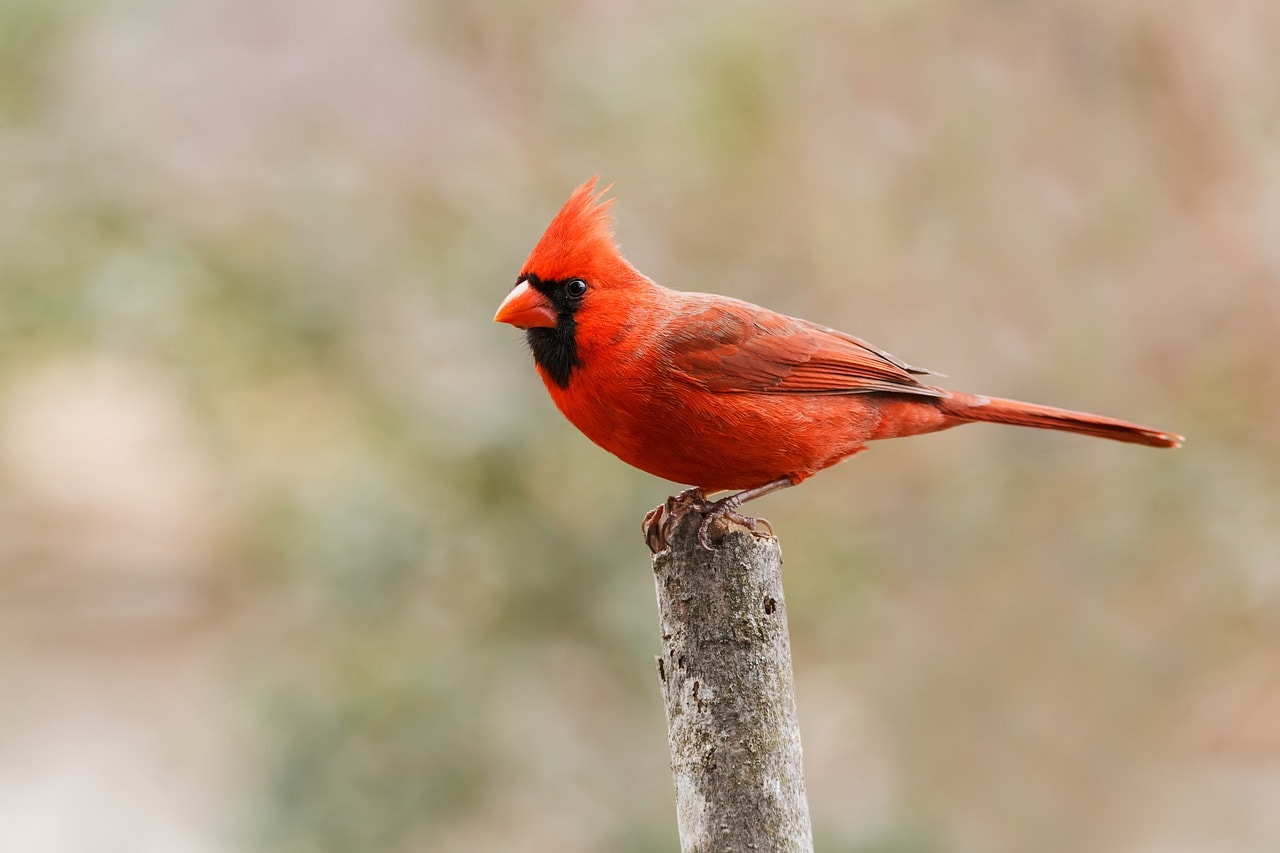
| Length | 8.75 inches |
| Wingspan | 12 inches |
| Habitat | Eastern US down to Texas and Arizona; Shrubby woodland edges |
| Diet | Herbivore |
| Colors | Red, orange, black, gray, brown |
| Scientific Name | Cardinalis cardinalis |
The Northern Cardinal is an easily recognizable red bird in Kansas, even for first-time bird watchers. Males have impressive scarlet and orange plumage with black beaks. Females are grayish-brown with orange tips and bright orange beaks. Both have a unique feather point at the tip of their heads. Northern Cardinals are ground foragers, but they love bird feeders with sunflower seeds.
3. American Crow

| Length | 17.5 inches |
| Wingspan | 30 inches |
| Habitat | Primarily eastern Kansas; semi-open areas |
| Diet | Omnivore |
| Colors | Black |
| Scientific Name | Corvus brachyrhynchos |
The dark ebony plumage and distinctive “caw” of crows are recognizable anywhere. Most people consider the American Crow the “parking lot bird” pecking at food waste. However, American Crows are far more intelligent than people credit them for. These birds are highly adaptable and quickly take advantage of new food sources—a reason why we see so many of them in parks and urban areas.
4. Black-Capped Chickadee
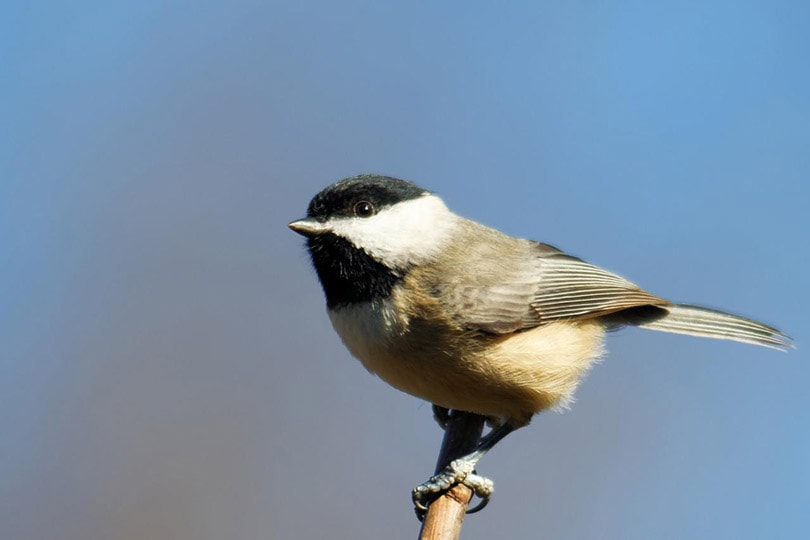
| Length | 4.75–5.25 inches |
| Wingspan | 8 inches |
| Habitat | Most of Kansas, except southern Kansas; deciduous and mixed forests |
| Diet | Omnivore |
| Colors | Black, white, gray |
| Scientific Name | Poecile atricapillus |
The Black-Capped Chickadee is a tiny bird with a curious personality that regularly comes to bird feeders. It has a black cap and throat with white cheeks and a white belly. The wings are a smoky gray mixed with white and black. Black-Capped Chickadees and Carolina Chickadees look the same, but their calls slightly differ.
5. Tufted Titmouse

| Length | 6.5 inches |
| Wingspan | 9.5 inches |
| Habitat | Mainly eastern Kansas; deciduous forests with canopy |
| Diet | Omnivore |
| Colors | Gray, white, orange |
| Scientific Name | Baeolophus bicolor |
The Tufted Titmouse is another small songbird in Kansas that visits backyards regularly, especially in dense, woody areas in eastern Kansas. This tiny bird is a grayish-white color with a white belly and gray and orange wings. You can recognize a Tufted Titmouse from its “peter-peter-peter” chirp. Place bird feeding trays outside with Black Oil Sunflower seeds and suet to attract a Titmouse.
6. White-Breasted Nuthatch

| Length | 5.75 inches |
| Wingspan | 11 inches |
| Habitat | Eastern Kansas |
| Diet | Omnivore |
| Colors | Dark gray, black, white |
| Scientific Name | Sitta carolinensis |
The White-Breasted Nuthatch is dark gray on the top of its body with black mixed into the wings. The belly is white, turning a rusted color closer to the back. The White-Breasted Nuthatch is an energetic little bird who loves to forage insects on tree bark. It often makes a honking noise while it looks for food.
This little bird is also savvy with opening acorns. It drives its beak into an acorn and then whacks it against a tree to get the nut open—hence the name. To attract a White-Breasted Nuthatch, offer large nuts, like sunflower seeds and peanuts with suet.
7. Common Grackle
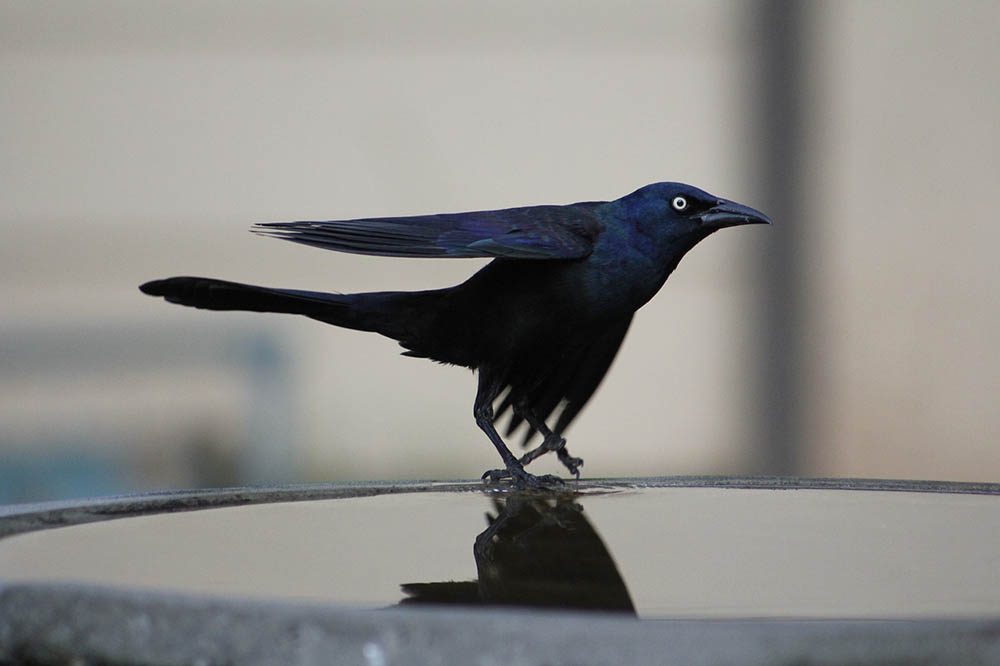
| Length | 12.5 inches |
| Wingspan | 17 inches |
| Habitat | Statewide |
| Diet | Omnivore |
| Colors | Black, blue, bronze |
| Scientific Name | Quiscalus quiscula |
A Common Grackle almost looks like a crow or raven from afar. But up close, you’ll see a dark blue and black cap with bronze and black wings. Sometimes the caps are a brighter blue color with some purple mixed in.
A Common Grackle likes to ground feed like a crow. Since this bird is a ground feeder, spreading seed and grain on the ground helps attract a Common Grackle to your backyard. This allows other birds to feed on the bird feeder as well. However, remember that ground food attracts rodents, so only spread enough for one feeding at a time.
8. Eastern Bluebird

| Length | 7 inches |
| Wingspan | 13 inches |
| Habitat | Statewide; Open areas |
| Diet | Omnivore |
| Colors | Blue, orange, white, black |
| Scientific Name | Sialia sialis |
The Eastern Bluebird has blue wings, a black beak, and a bronze and white belly. Male Eastern Bluebirds are more prominent in their blue color. Females have black and gray on their wings with a touch of blue on their bottom wing feathers.
Eastern Bluebirds have a short, wavering call that you can hear from telephone poles or on top of nest boxes. They eat mostly wild insects, nuts, and berries and often don’t come to bird feeders. However, they will visit a backyard if mealworms are offered.
9. American Robin
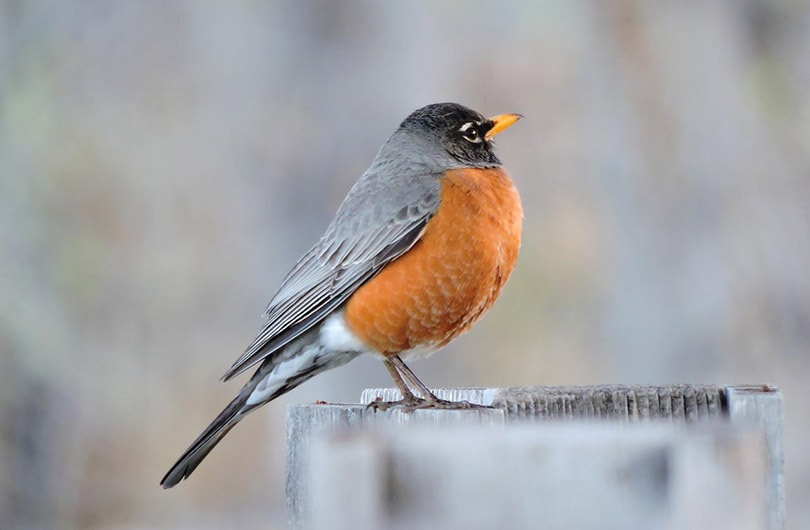
| Length | 10 inches |
| Wingspan | 17 inches |
| Habitat | Statewide; Open areas |
| Diet | Omnivore |
| Colors | Red, black, gray |
| Scientific Name | Turdus migratorius |
The American Robin is a popular red bird in Kansas. It has a black cap, dark gray wings, and a reddish-orange breast. Thankfully, even beginner bird watchers can easily recognize this bird from its distinct plumage coloring.
The American Robin sings a cheery trill and loves to visit backyards with bird feeders. Most of an American Robin’s diet comes from feeding on lawns. This does make it susceptible to pesticide poisoning, so it’s best not to attract American Robins if you use pesticides.
10. Chipping Sparrow
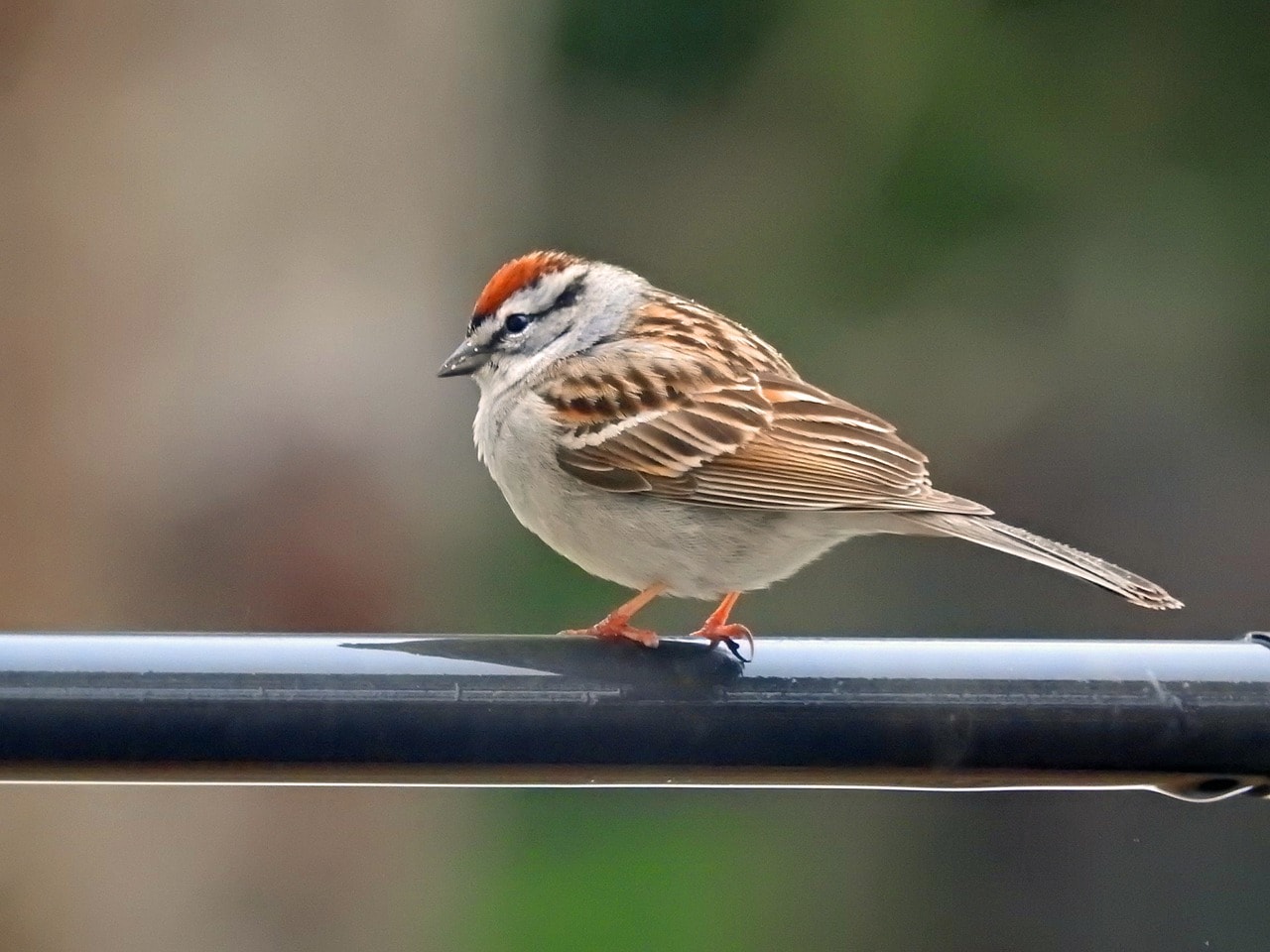
| Length | 5.5 inches |
| Wingspan | 8.5 inches |
| Habitat | Statewide |
| Diet | Omnivore |
| Colors | Gray, brown, black, white |
| Scientific Name | Spizella passerina |
The Chipping Sparrow is a frequent lawn visitor, mainly because it’s finding twigs to make its nest. This brown bird in Kansas has an interesting black stripe through the eye, making it easy for beginner bird watchers to identify this bird.
The biggest indicator a Chipping Sparrow is nearby is when it sings a long trill from treetops. To attract a Chipping Sparrow, offer Black Oil Sunflower seeds in bird feeders and sprinkle a few on the ground.
11. Red-Winged Blackbird
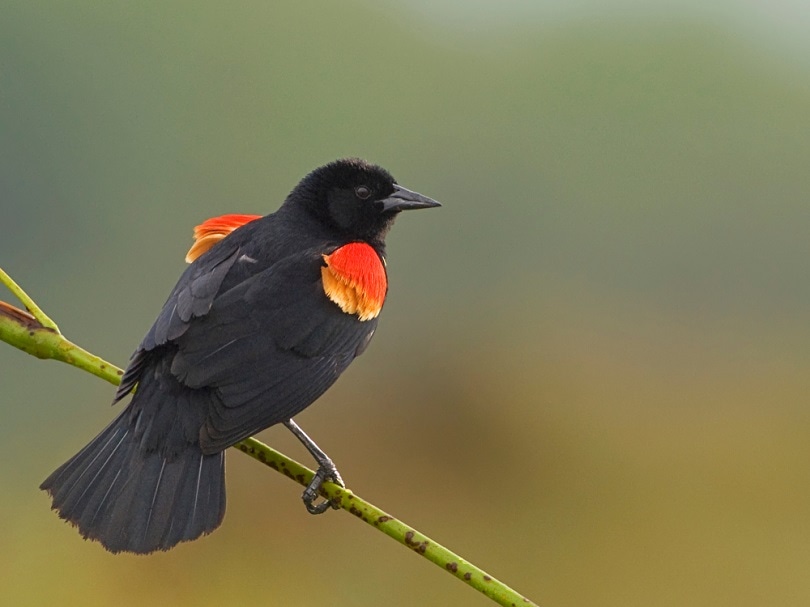
| Length | 8.75 inches |
| Wingspan | 13 inches |
| Habitat | Statewide |
| Diet | Omnivore |
| Colors | Red, black, brown, rust, white |
| Scientific Name | Agelaius phoeniceus |
The male Red-Winged Blackbird gives the name its meaning. This bird is all black with a red stripe on the wing. However, the female Red-Winged Blackbird isn’t black at all. It’s primarily brown, rust, and white with a dark line across the face. This bird is a ground feeder and typically feeds on insects, corn, and wheat.
To attract a Red-Winged Blackbird, spread some corn and wheat on the ground.
12. House Finch
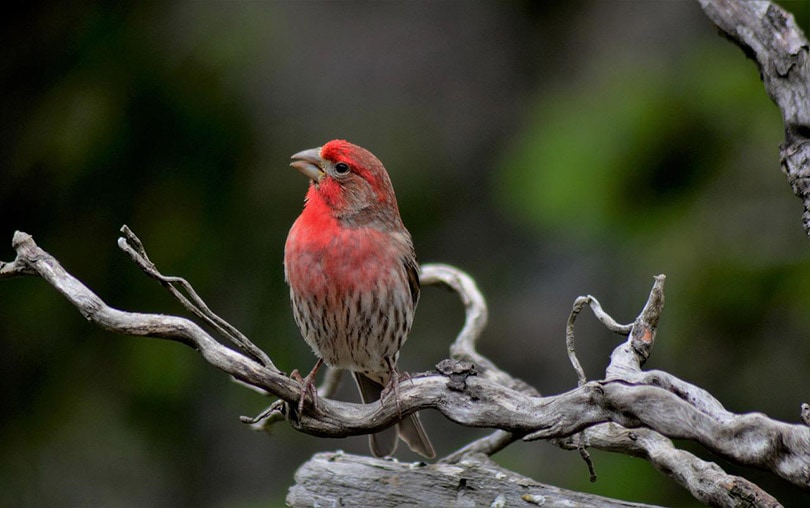
| Length | 6 inches |
| Wingspan | 9.5 inches |
| Habitat | Statewide |
| Diet | Herbivore |
| Colors | Brown, gray, white, red |
| Scientific Name | Haemorhous mexicanus |
The House Finch is a small, plump Kansas red bird. The House Finch used to be native only to the western US but recently has made its way to the east and is now a common bird all across Kansas. The House Finch has a long, twittering song and likes to forage on the ground. Like the American Robin, you can find the House Finch pecking away at your front or backyard.
13. American Goldfinch
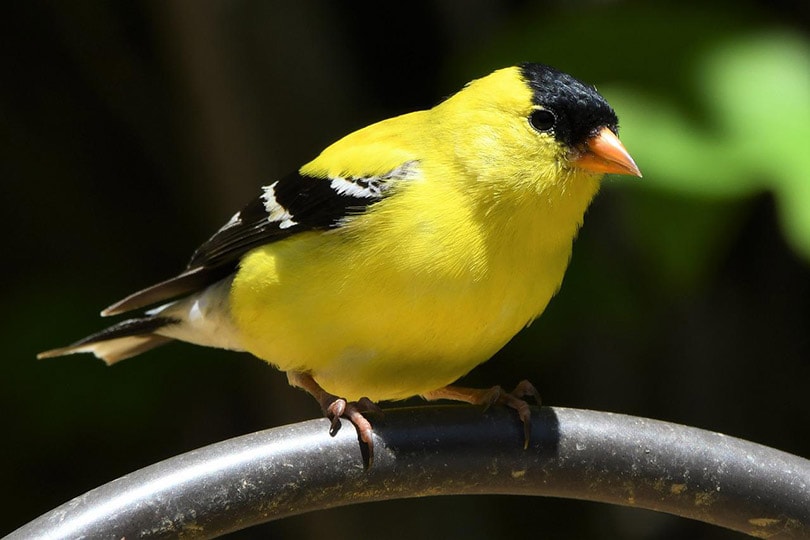
| Length | 5 inches |
| Wingspan | 9 inches |
| Habitat | Statewide |
| Diet | Herbivore |
| Colors | Yellow, black, brown, gray |
| Scientific Name | Spinus tristis |
The American Goldfinch is an easy bird to spot for beginner birders except in dense, woody areas. But don’t worry—you’ll see American Goldfinches near many bird feeders across Kansas. The breeding male is a vibrant lemon yellow with black and white patterning. Non-breeding males and females are mostly tan.
If you want to attract American Goldfinches to your backyard, plant native milkweed and thistle. These little birds are also happy to peck at any spilled birdseed on the ground since they are ground feeders.
14. House Sparrow

| Length | 6.25 inches |
| Wingspan | 9.5 inches |
| Habitat | Statewide |
| Diet | Omnivore |
| Colors | Gray, brown, black |
| Scientific Name | Passer domesticus |
The House Sparrow was given its name because this bird goes wherever there are humans. These birds are dull gray, brown, and black in color. They’re so common that most people overlook them. They can be a nuisance since they like to push native birds away from feeders and houses. You don’t need to attract this bird breed to your yard because odds are, it will find a way there regardless.
15. Red-Bellied Woodpecker
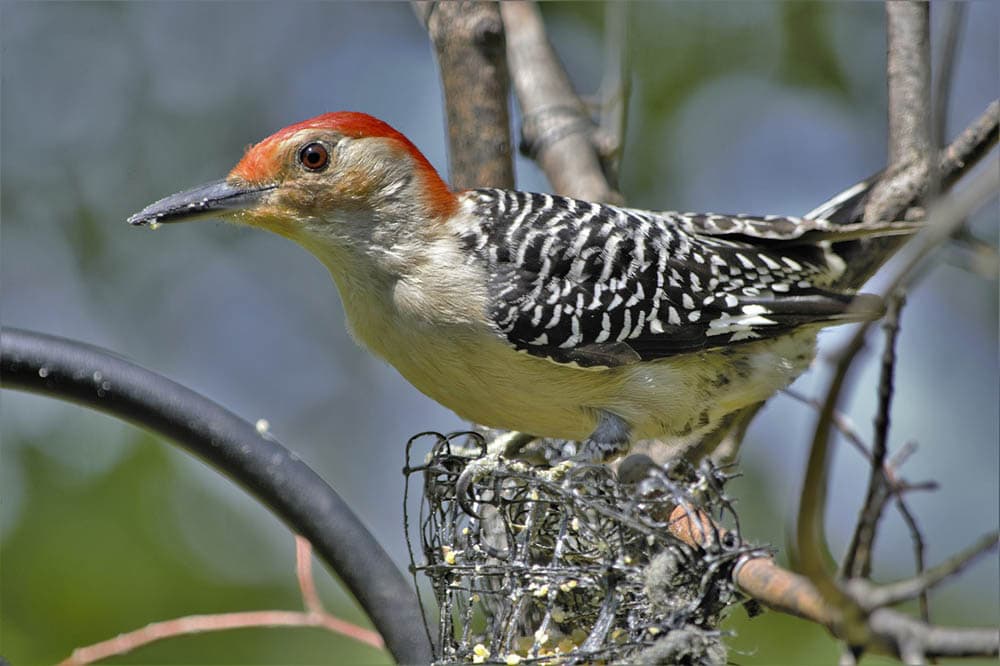
| Length | 9.25 inches |
| Wingspan | 16 inches |
| Habitat | Statewide, Southwest excluded; Prefers woody areas |
| Diet | Omnivore |
| Colors | Black, white, red |
| Scientific Name | Melanerpes carolinus |
Male and female Red-Bellied Woodpeckers look almost identical with a scarlet cap and black wings with white dots. This bird prefers woody areas and likes to forage on tree bark. It stores much of its food in the cracks of tree bark, so you can attract a Red-bellied Woodpecker if you live near an area with lots of trees. Sometimes, these red birds will feed on Hummingbird feeders. Fill your feeders with suet, sunflower seeds, and peanuts.
- Related Read: 8 Types of Hummingbirds in Kansas
16. Downy Woodpecker
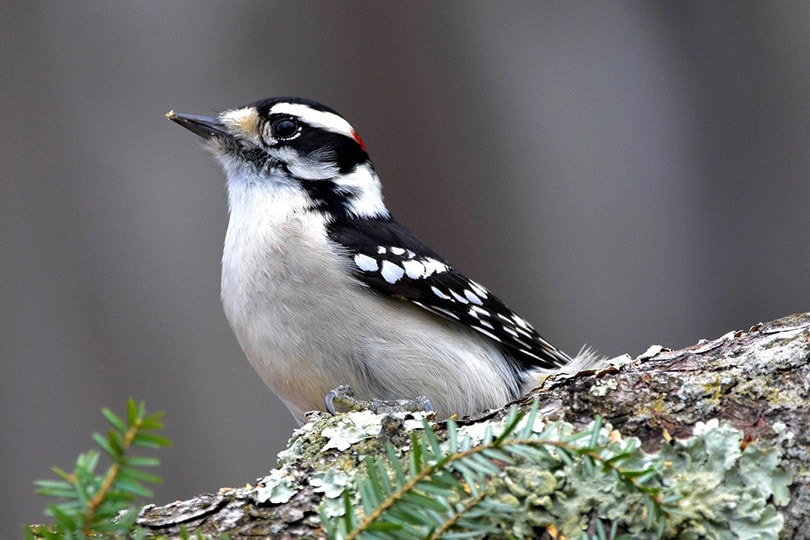
| Length | 6.75 inches |
| Wingspan | 12 inches |
| Habitat | Statewide |
| Diet | Omnivore |
| Colors | White, black, red |
| Scientific Name | Picoides pubescens |
The Downy Woodpecker is another beautiful red bird with black and white stripes and a bright red spot on the back of the head. The black and white coloring continues on the wings, but instead of stripes, they’re dots.
The Downy Woodpecker has a classic bird chip that sounds like a little squeak. You can find this bird foraging on tree bark, similar to other woodpeckers. It prefers to hang out on small branches and is one of the few woodpeckers to visit bird feeders. To attract a Downy Woodpecker, offer sunflower seeds, peanut butter, millet, and peanuts.
17. Mourning Dove
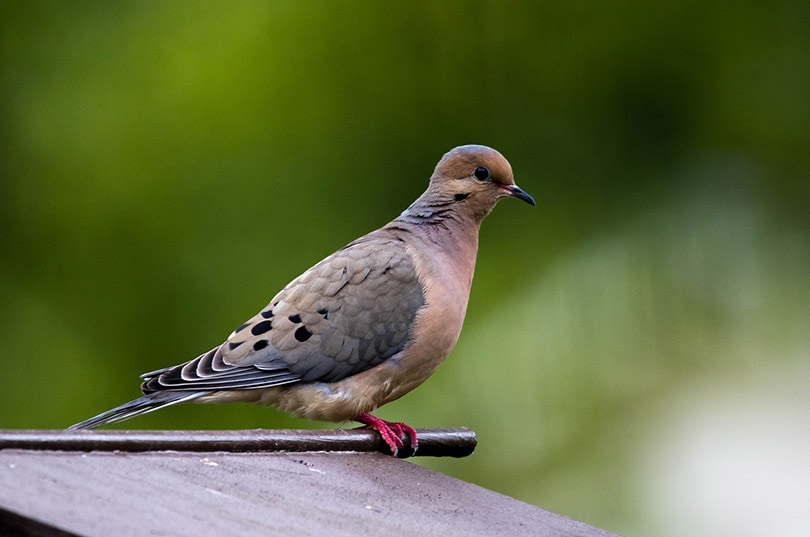
| Length | 12 inches |
| Wingspan | 18 inches |
| Habitat | Statewide |
| Diet | Herbivore |
| Colors | Gray, brown, black, white |
| Scientific Name | Zenaida macroura |
The Mourning Dove is a pale brown bird with a pointed tail. The sound of a Mourning Dove sounds a little soft and sad. Although this popular Kansas songbird has a melancholy tune, it’s comforting to hear.
You can find Mourning Doves resting on telephone poles and looking for seeds on the ground. To attract Mourning Doves, scatter millet or other seed on the ground or put them in a platform feeder.
18. Northern Flicker

| Length | 12.5 inches |
| Wingspan | 20 inches |
| Habitat | Statewide |
| Diet | Omnivore |
| Colors | White, black, yellow, red, gray |
| Scientific Name | Colaptes auratus |
The Northern Flicker has a striped back with a white belly and black spotting. There’s also a memorable black crescent at the top of the chest and a red stripe stemming from the mouth. This bird is a ground forager, eating mainly ants and beetles. The best way to attract a Northern Flicker to your yard is to put up a nesting box to attract a breeding pair.
19. European Starling
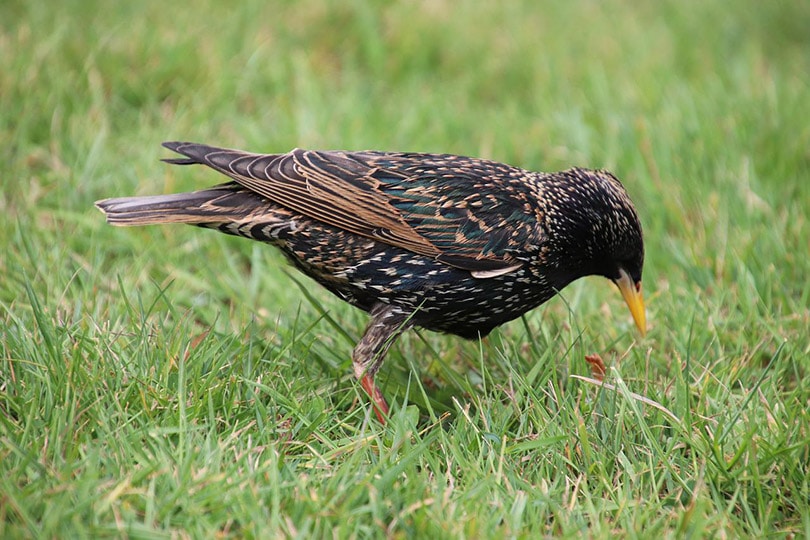
| Length | 8.5 inches |
| Wingspan | 16 inches |
| Habitat | Statewide |
| Diet | Omnivore |
| Colors | Green, black, yellow, gray, brown |
| Scientific Name | Sturnus vulgaris |
The European Starling looks like a stained-glass window. Its colors blend beautifully, with a glossy purple color starting at the head and turning into a dark blue toward the wings. The wings have white tips, and the beak is bright yellow.
Non-breeding birds are mostly tan, with some green and bronze in their feathers. A European Starling’s chirp is soft and slightly shrill. This bird is the continent’s most numerous songbird and prefers to forage on the ground.
20. Dark-Eyed Junco

| Length | 6.25 inches |
| Wingspan | 9.25 inches |
| Habitat | Statewide |
| Diet | Omnivore |
| Colors | Gray, white |
| Scientific Name | Junco hyemalis |
The Dark-Eyed Junco is a tiny, plump sparrow with a black top and white underside. They have bright white tail feathers that make them easy to identify. Many people know this bird as the “snowbird” in the east because they appear when winter sets in. Dark-eyed Juncos are ground foragers but regularly visit bird feeders.
Summer Residents
21. Western Kingbird

| Length | 8.75 inches |
| Wingspan | 15 inches |
| Habitat | Mostly western Kansas, some southern counties excluded |
| Diet | Omnivore |
| Colors | Gray, yellow, black, white |
| Scientific Name | Tyrannus verticalis |
Western Kingbirds have a gray cap, brown feathers, and yellow belly. These birds are primarily found in western Kansas in rural areas with open fields. The chirp is similar to a mouse squeak and can only be heard during the summertime. When summer does arrive, these birds perch on trees and telephone lines until a bug flies by. Then, they aggressively fly and snatch the bug!
22. Eastern Kingbird

| Length | 8.5 inches |
| Wingspan | 15 inches |
| Habitat | Most of Kansas, less common in western Kansas |
| Diet | Omnivore |
| Colors | Blue, Black, gray, white, gray |
| Scientific Name | Tyrannus tyrannus |
This Eastern Kingbird may be small, but it makes up for it with personality. This bird is black on top and white on the belly. It almost looks like it’s wearing a business suit. The Eastern Kingbird is a flycatcher, just like the Western Kingbird, except it claims the eastern part of Kansas. Berry bushes can help attract Eastern Kingbirds to your yard.
23. Barn Swallow

| Length | 6.75 inches |
| Wingspan | 15 inches |
| Habitat | Statewide |
| Diet | Carnivore |
| Colors | Blue, black, rusty orange |
| Scientific Name | Hirundo rustica |
Barn Swallows are eye-catching with blue and orange coloring. You’ll find many Barn Swallows foraging in the sky for their food, so look for a long, forked tail in the sky.
These birds don’t care for bird feeders since they’re aerial foragers, but platform feeders could work. If you start offering food, be prepared to find muddy bird nests around the house!
24. House Wren

| Length | 4.75 inches |
| Wingspan | 6 inches |
| Habitat | Statewide |
| Diet | Carnivore |
| Colors | Brown, black |
| Scientific Name | Troglodytes aedon |
House Wrens are compact, plump little birds that are tan all over their body. These birds are very common, so it’s unlikely you’ll need to put forth any effort attracting one. They will happily nest in boxes, old cans, boots, or other materials you have lying around the yard.
25. Brown Thrasher
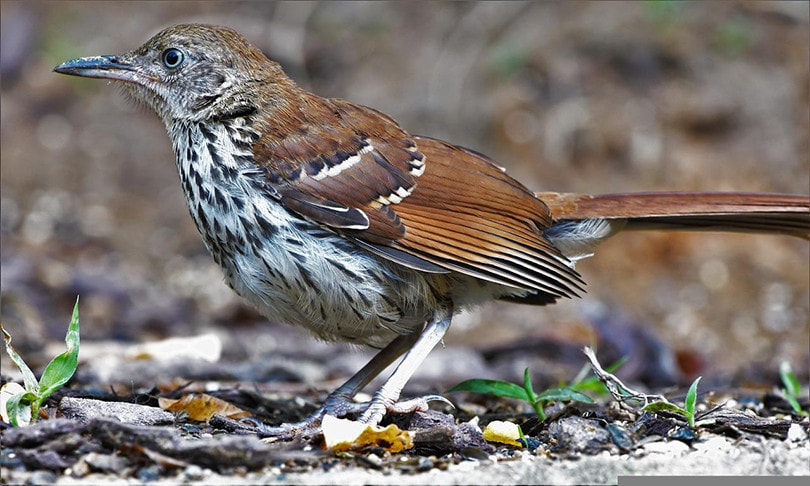
| Length | 11.5 inches |
| Wingspan | 13 inches |
| Habitat | Statewide |
| Diet | Omnivore |
| Colors | Brown, black |
| Scientific Name | Toxostoma rufum |
These little birds are popular Kansas songbirds. Brown Thrashers are reddish-brown on top with white bellies sprinkled with black specks. Despite their size, they produce a powerful voice. Brown Thrashers like to hang out in shrubs and visit any backyard where food is offered.
Winter Residents
26. Yellow-Rumped Warbler
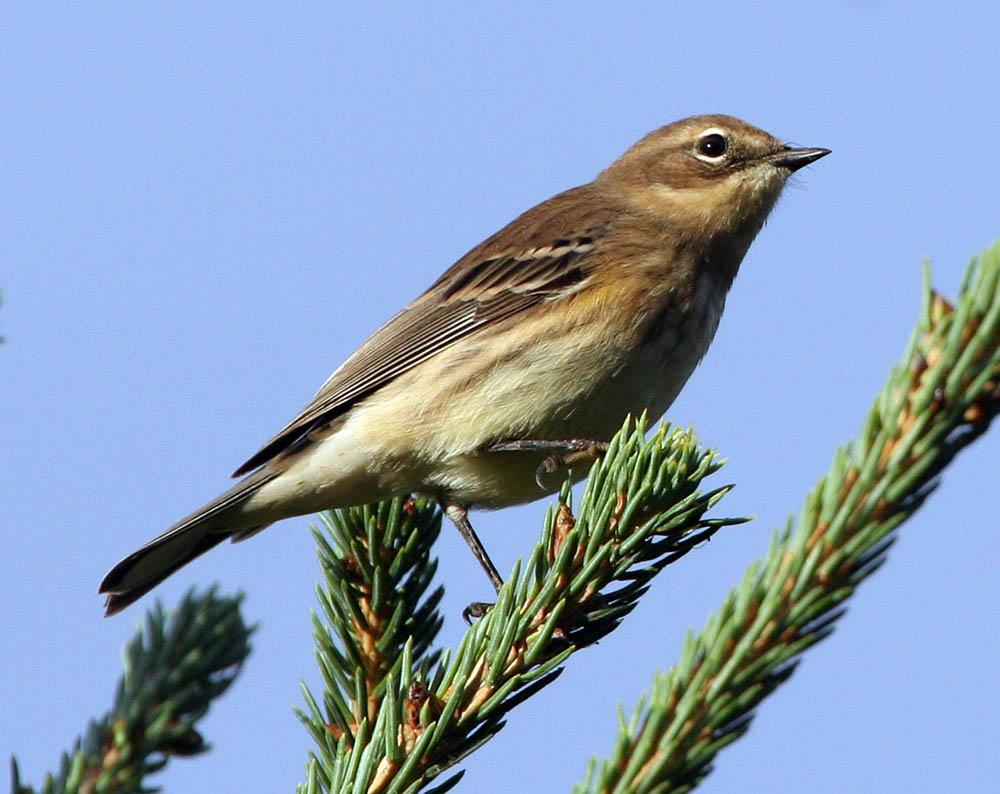
| Length | 5 inches |
| Wingspan | 8 inches |
| Habitat | Statewide, less common in the west |
| Diet | Omnivore |
| Colors | Yellow, green, black, gray |
| Scientific Name | Setophaga petechia |
The Yellow-Rumped Warbler is a beautiful yellow, gray, and blackbird with green hidden in the feathers. These little guys like to hang out in shrubs and trees, so if you hear a sharp chirp, that’s where to look first!
The Yellow-Rumped Warbler is a winter bird in Kansas but is very hardy at finding food. Try laying out peanut butter, raisins, sunflower seeds, and suet to attract the Yellow-Rumped Warbler to your property.
27. American Tree Sparrow

| Length | 6.25 inches |
| Wingspan | 9.5 inches |
| Habitat | Statewide |
| Diet | Omnivore |
| Colors | Brown, black, gray, yellow |
| Scientific Name | Spizella arborea |
American Tree Sparrows are a beautiful bronze on the cap and wings with white and gray mixed in on the breast. These birds love to visit during the winter. You can often find them foraging on snow-covered fields statewide. Once the snow melts, these birds migrate north. To attract American Tree Sparrows to your yard, leave your bird feeder out during the winter.
28. White-Crowned Sparrow

| Length | 7 inches |
| Wingspan | 9.5 inches |
| Habitat | Statewide |
| Diet | Herbivore |
| Colors | White, black, brown, gray, pinkish-orange |
| Scientific Name | Zonotrichia leucophrys |
White-Crowned Sparrows appear during the winter to ground forage. These birds have black and white stripes on their cap, a pale orange beak, brown wings, and a light gray breast. Their chirp is thin and shrill, and they often feed in groups. They enjoy visiting backyards, so leave your bird feeders out with sunflower seeds!
Conclusion
Kansas has the best birdwatching opportunities right from your doorstep. Even if you’re not interested in birdwatching, sitting outside and listening to the melody of bird songs is quite pleasing. With this list, you can start identifying birds that frequent your lawn and maybe start building relationships with the wildlife around you. What better way to start the day than with the sound of songbirds?
See also:
- 22 Common Backyard Birds in South Carolina
- 33 Common Backyard Birds in Maryland
- 30 Common Backyard Birds in Washington
- 28 Common Backyard Birds in Ohio
Sources
Featured Image Credit: alphanumericlogic, Pixabay
Table of Contents
- The 28 Most Common Backyard Birds in Kansas
- Year-Round Residents
- 1. Blue Jay
- 2. Northern Cardinal
- 3. American Crow
- 4. Black-Capped Chickadee
- 5. Tufted Titmouse
- 6. White-Breasted Nuthatch
- 7. Common Grackle
- 8. Eastern Bluebird
- 9. American Robin
- 10. Chipping Sparrow
- 11. Red-Winged Blackbird
- 12. House Finch
- 13. American Goldfinch
- 14. House Sparrow
- 15. Red-Bellied Woodpecker
- 16. Downy Woodpecker
- 17. Mourning Dove
- 18. Northern Flicker
- 19. European Starling
- 20. Dark-Eyed Junco
- Summer Residents
- Winter Residents
- Conclusion
About the Author Cassidy Sutton
Cassidy is a vet tech and pet sitter who has more recently become a animal writer. She loves cats and dogs and has had dozens of pets over the years. Her specialty is the human-animal bond. Cassidy and her husband currently live in Kansas with a German Shepherd named Raven, two cats named Lucy and Streudel, and several backyard chickens.
Related Articles:
Monocular vs Telescope: Differences Explained (With Pictures)
10 Types of Hummingbirds in Arkansas (With Pictures)
8 Types of Hummingbirds in Nebraska (With Pictures)
5 Types of Hummingbirds in Idaho (With Pictures)
3 Types of Hummingbirds in Mississippi (With Pictures)
8 Types of Hummingbirds in Kansas (With Pictures)
5 Types of Hummingbirds in West Virginia (With Pictures)
5 Types of Hummingbirds in Ohio (With Pictures)
